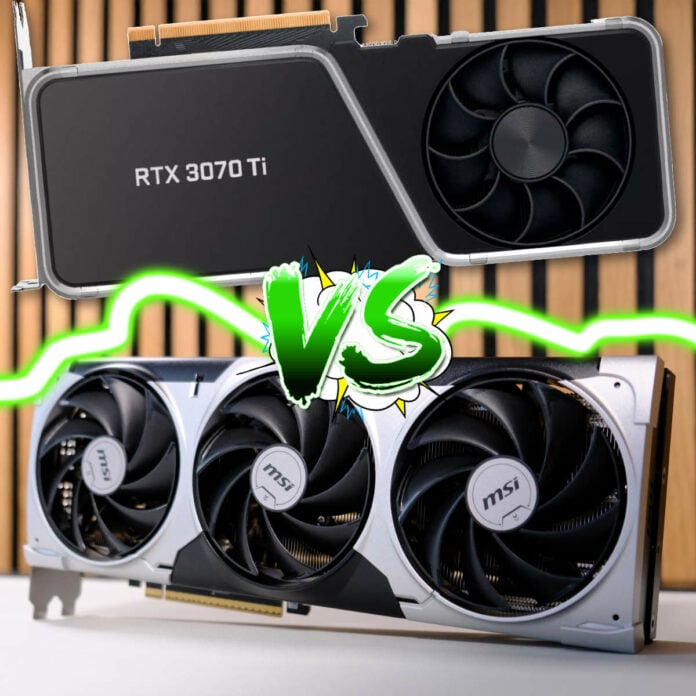Much has changed in the realms of rendering since GeForce RTX 3070 Ti launched back in 2021, to the point that Nvidia’s older card is already starting to noticeably fall behind in many respects. Thankfully, upgrading your graphics card every-other-generation is a perfectly reasonable decision and there’s much to gain by opting for the likes of RTX 5070 Ti in place of ageing Ampere.
Before we dive into comparisons between the two cards, I should note that GeForce RTX 5070 Ti is a fair whack more expensive than RTX 3070 Ti was at launch. If your budget can’t stretch beyond that $600 threshold then alternatives are en route in the form of RTX 5070 potentially alongside offerings from AMD. If you can spend a little extra, then you’re in for quite the upgrade.
Specs
Examining the specifications of GeForce RTX 5070 Ti and RTX 3070 Ti side-by-side showcases how Nvidia has shifted its design of this graphics card class over several years. Of course, moving from an 8nm to 4nm process affords the company many advantages and room to innovate. For starters, GB203’s transistor count is exponentially larger and denser than GA104, carrying 120.6m/mm² of die space to its predecessor’s 44.4m/mm².
| RTX 5070 Ti | RTX 3070 Ti | Ratio | |
|---|---|---|---|
| Released | Feb 2025 | Jun 2021 | – |
| Codename | Blackwell | Ampere | – |
| GPU | GB203 | GA104 | – |
| Process | TSMC 4N (4nm) | Samsung 8nm | – |
| Transistors | 45.6bn | 17.4bn | 2.62 |
| Die size | 378mm² | 392mm² | 0.96 |
| Cores | 8,960 | 6,144 | 1.46 |
| Base clock | 2,300MHz | 1,575MHz | 1.46 |
| Boost clock | 2,452MHz | 1,770MHz | 1.39 |
| FP32 Boost TFLOPS | 43.9 | 21.7 | 2.02 |
| SM count | 70 of 84 | 48 of 48 | 1.46 |
| RT cores | 70 (4th Gen) | 48 (2nd Gen) | 1.46 |
| RT TFLOPS | 133.2 | 42.5 | 3.13 |
| Tensor cores | 280 (5th Gen) | 192 (3rd Gen) | 1.46 |
| FP16 Acc TFLOPS | 351.5 | 174.0 | 2.02 |
| ROPS | 96 | 96 | 1.00 |
| Memory | 16GB | 8GB | 2.00 |
| Memory type | GDDR7 | GDDR6X | – |
| Mem. clock | 28Gb/s | 19Gb/s | 1.47 |
| Mem. interface | 256-bits | 256-bits | 1.00 |
| Mem. bandwidth | 896GB/s | 608GB/s | 1.47 |
| Board power | 300W | 290W | 1.03 |
| Launch MSRP | $749 | $599 | 1.25 |
CUDA, RT, and Tensor cores (oh my!) are substantially greater in quality and number on GeForce RTX 5070 Ti relative to RTX 3070 Ti. Nvidia crams 46% more of every subcomponent in its latest card, naturally greatly boosting rasterised and ray traced rendering performance alongside beefing up AI chops. Clock speeds are notably higher too, as the Blackwell newcomer’s base frequency of 2,300MHz surpasses the boost clock of the Ampere pixel pusher, and even MSRP versions of the GPU reach as high as 2,857MHz.
Save for an identical 256-bit interface, the memory configurations of GeForce RTX 3070 Ti and 5070 Ti couldn’t be more different. An 8GB buffer can often prove problematic in modern games, particularly at higher resolutions, so a doubling to 16GB on the latter card is a great improvement. The same pixel pusher also enjoys considerably faster GDDR7 chips, running at 28Gb/s, affording it a total bandwidth of 896GB/s to its forebear’s 608GB/s.
Nvidia hasn’t dramatically increased board power in the past several years for its 70 Ti cards, bumping up TDP by 10W on GeForce RTX 5070 Ti for a reasonable total of 300W. While some partner models of RTX 3070 Ti donned 8-pin power connectors, you’ll need a 16-pin cable or dongle handy to power the beefier pixel pusher.
GeForce RTX 5070 Ti does carry a higher price than RTX 3070 Ti did at launch, costing $749 instead of $599. Taking into account recent rampant worldwide inflation and tariffs, it’s an unfortunate but understandable change. Thankfully, this 25% bump comes with a performance boost that’s much, much larger.
Performance
Giving GeForce RTX 3070 Ti one last hurrah, it enters the arena against RTX 5070 Ti with fresh benchmarks captured in the Club386 7950X3D test bench. All’s fair in both hardware and software, with each graphics card running the latest Game Ready drivers on Windows 11 24H2.
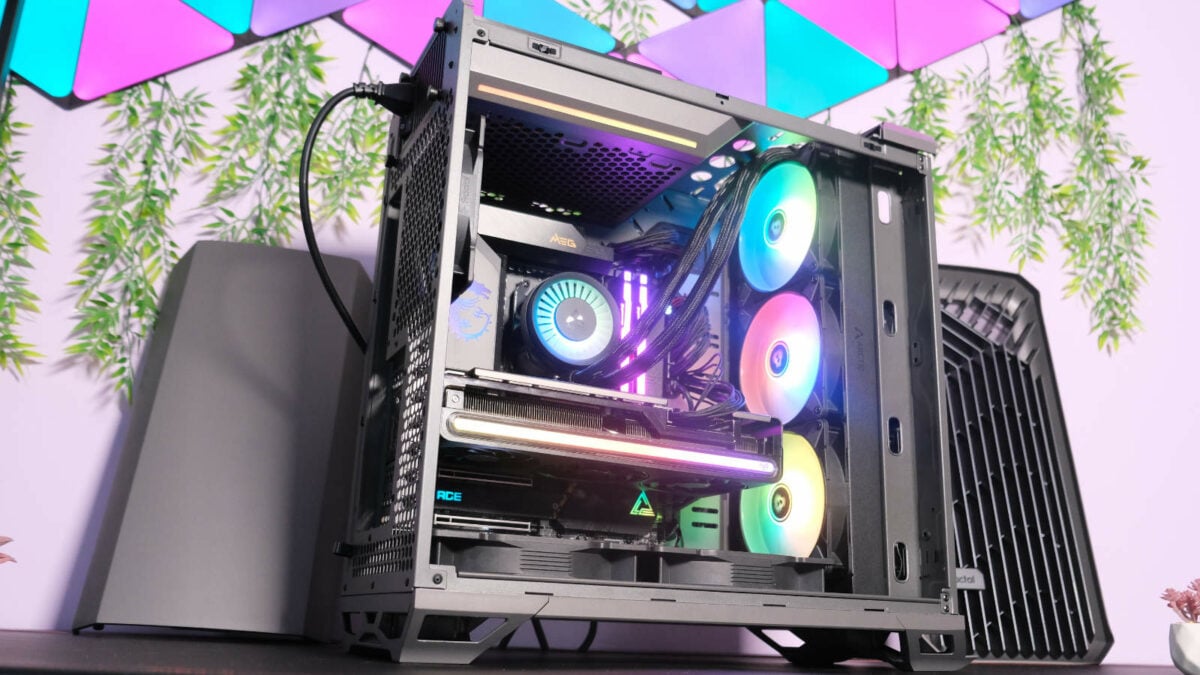
Our 7950X3D Test PCs
Club386 carefully chooses each component in a test bench to best suit the review at hand. When you view our benchmarks, you’re not just getting an opinion, but the results of rigorous testing carried out using hardware we trust.
Shop Club386 test platform components:
CPU: AMD Ryzen 9 7950X3D
Motherboard: MSI MEG X670E ACE
Cooler: Arctic Liquid Freezer III 420 A-RGB
Memory: 64GB Kingston Fury Beast DDR5
Storage: 2TB WD_Black SN850X NVMe SSD
PSU: be quiet! Dark Power Pro 13 1,300W
Chassis: Fractal Design Torrent Grey
As much as GeForce RTX 5070 Ti is capable of rendering games at UHD, RTX 3070 Ti unfortunately isn’t quite as capable. Regardless, benchmarks for both cards at that resolution, as well as FHD and QHD, are ready to read below.
Application and AI
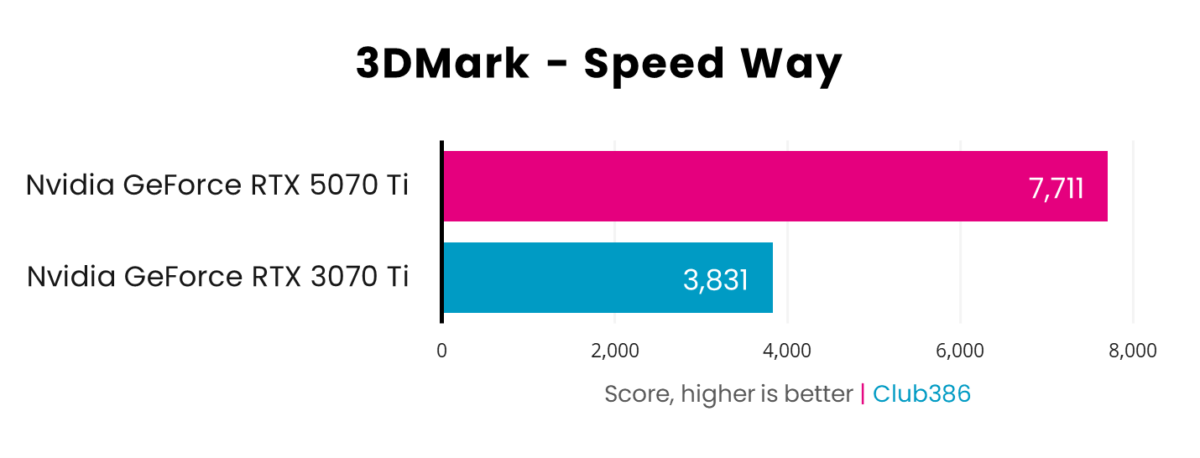
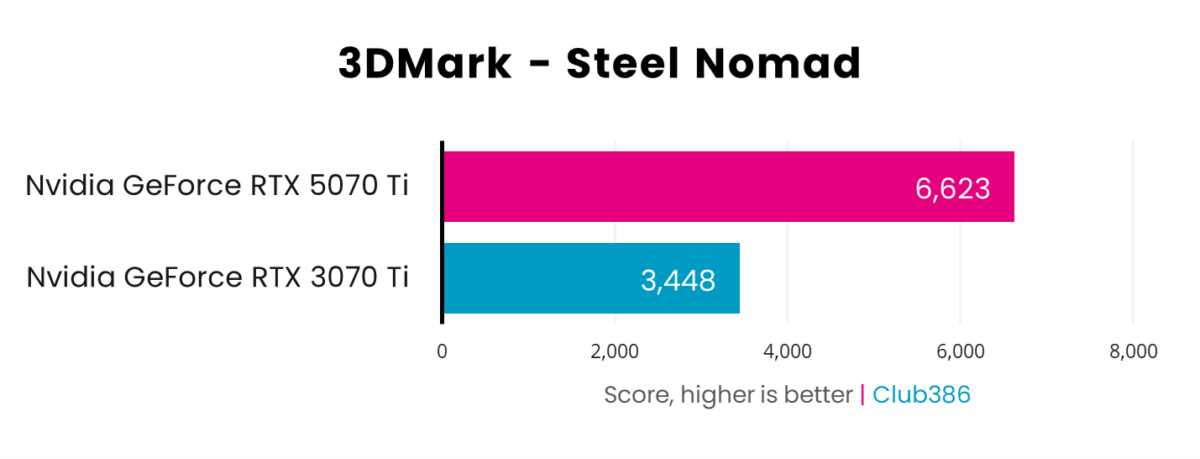
What a difference almost four years of progress can make. GeForce RTX 5070 Ti outright doubles RTX 3070 Ti’s score in 3DMark Speed Way and comes close to doing the same in Steel Nomad with a 92% improvement. Suffice to say, Nvidia’s Blackwell architecture runs circles around Ampere in both rasterised and ray traced rendering.
Real-world performance is naturally lower than these synthetic tests suggest. Nonetheless, they do set the stage for GeForce RTX 5070 Ti to offer a mighty impressive upgrade to RTX 3070 Ti.
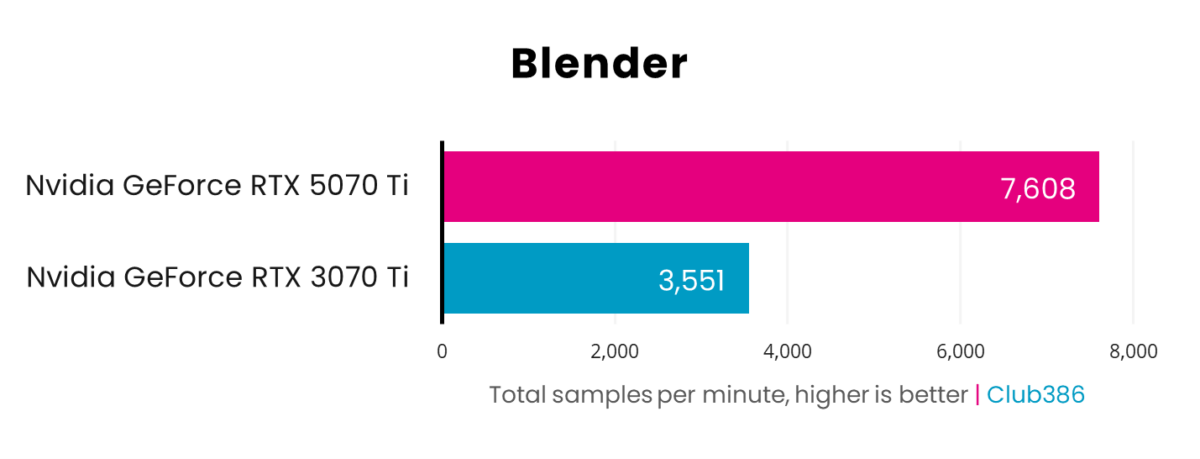
Raw GPU horsepower combined with more-modern NVENC and NVDEC media engines give GeForce RTX 5070 Ti an enormous leg up in production applications compared to RTX 3070 Ti. The Blackwell card also has a greater number of NVENC engines, boasting two in place of its predecessor’s one. The benefits of all these qualities are plain to see in Blender, with a 114% rise in samples per minute.
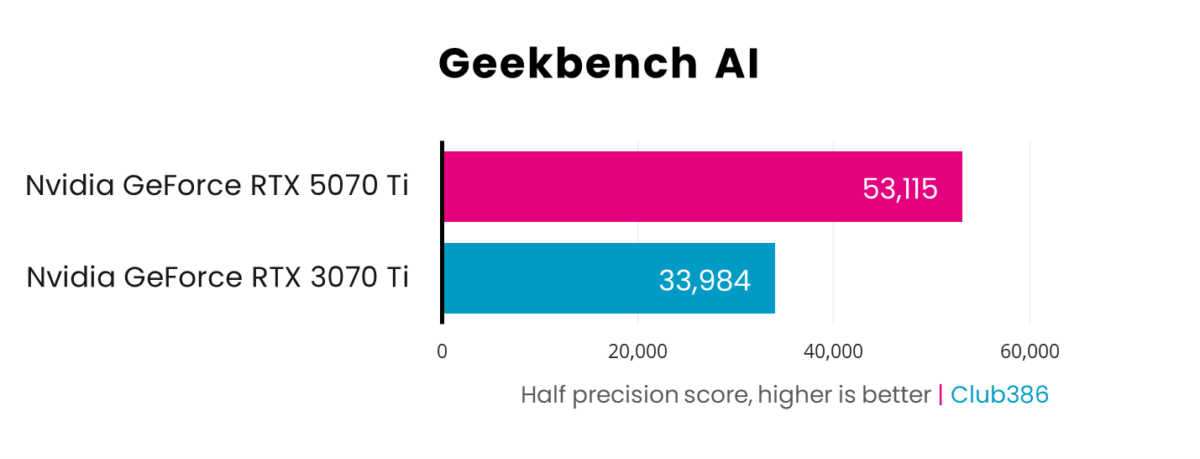
Advancements in Tensor core design naturally nets greater AI performance for GeForce RTX 5070 Ti. Its half precision (FP16) score in Geekbench AI of 53,115 puts it ahead of RTX 3070 Ti to the tune of 56%.
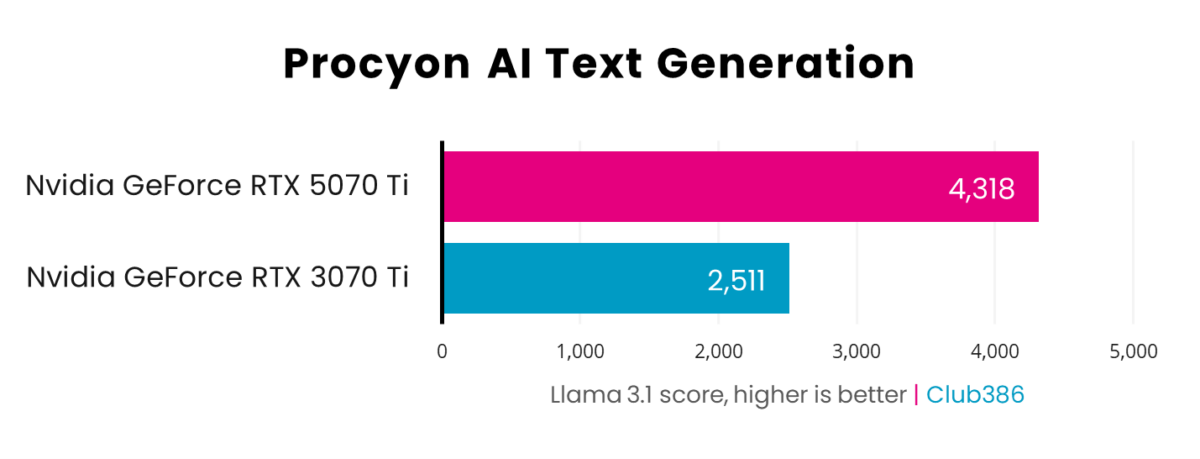
By the same token (pun intended), GeForce RTX 5070 Ti runs LLMs (Large Language Models) more effectively. Its larger 16GB memory buffer also makes it compatible with more-demanding models. The difference between the Blackwell newcomer and RTX 3070 Ti running Llama 3.1 amounts to a 71% boost in favour of the former card.
Gaming
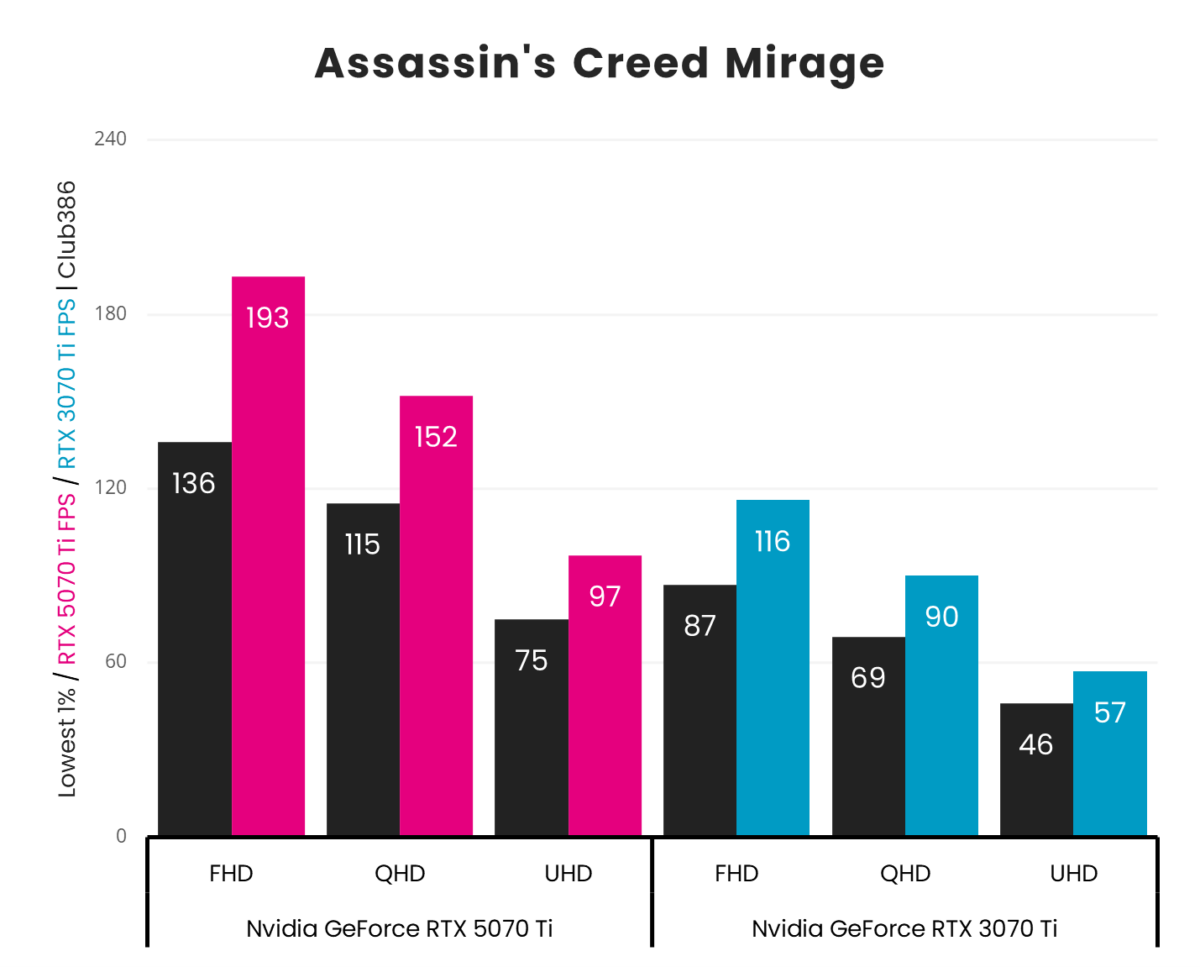
GeForce RTX 3070 Ti remains a solid graphics card for rasterised rendering, delivering confident frame rates in Assassin’s Creed Mirage at FHD and QHD. It even comes close to pumping out 60fps at native UHD. However, the pixel pusher pales in comparison to RTX 5070 Ti as it pulls ahead by 66-70% across all three resolutions.
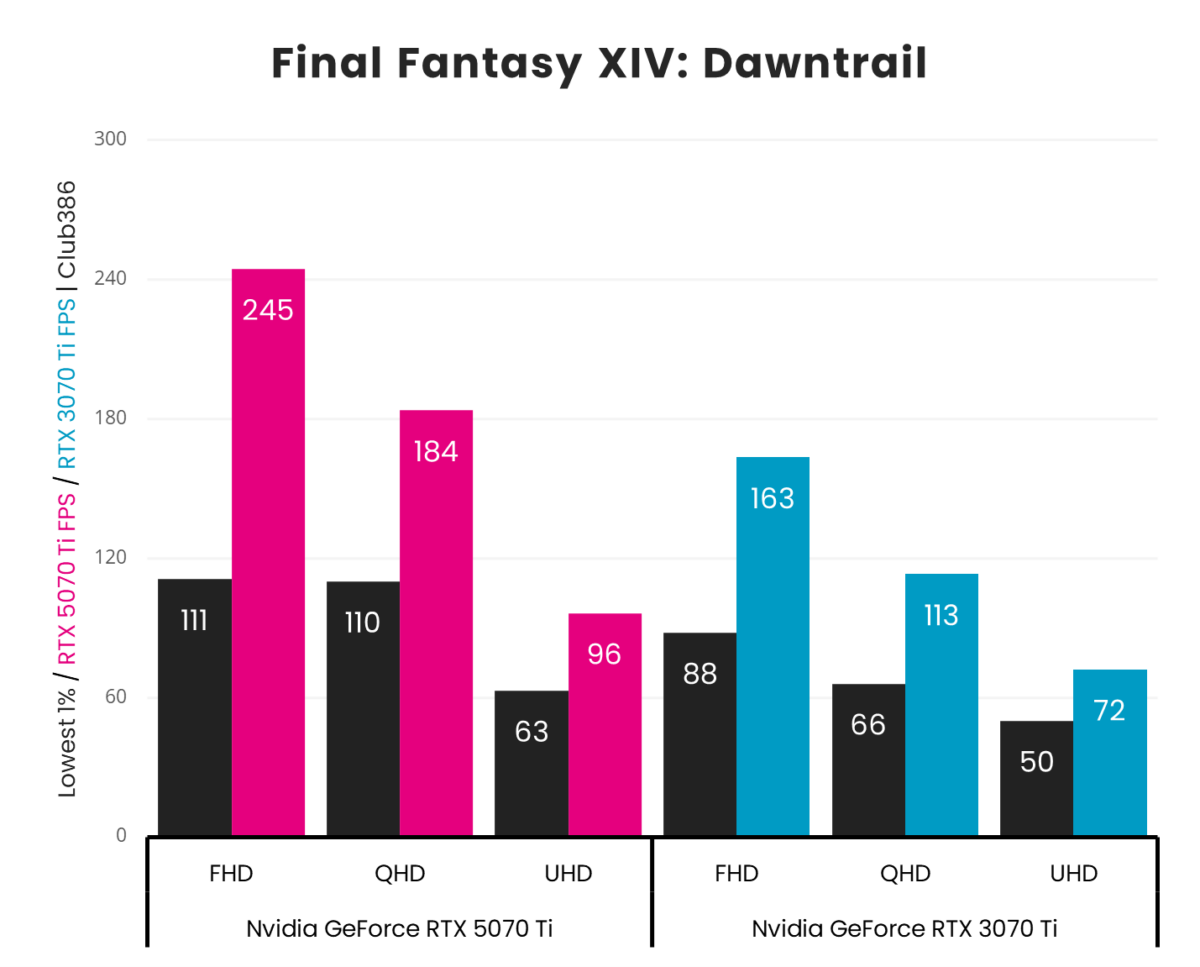
GeForce RTX 5070 Ti provides a similarly welcome boost to frame rates in Final Fantasy XIV: Dawntrail. The gains are less pronounced in the MMORPG overall, ranging from 33-63% but the graphics card does unlock the potential to fully enjoy it with a 180Hz or even 240Hz refresh rate.
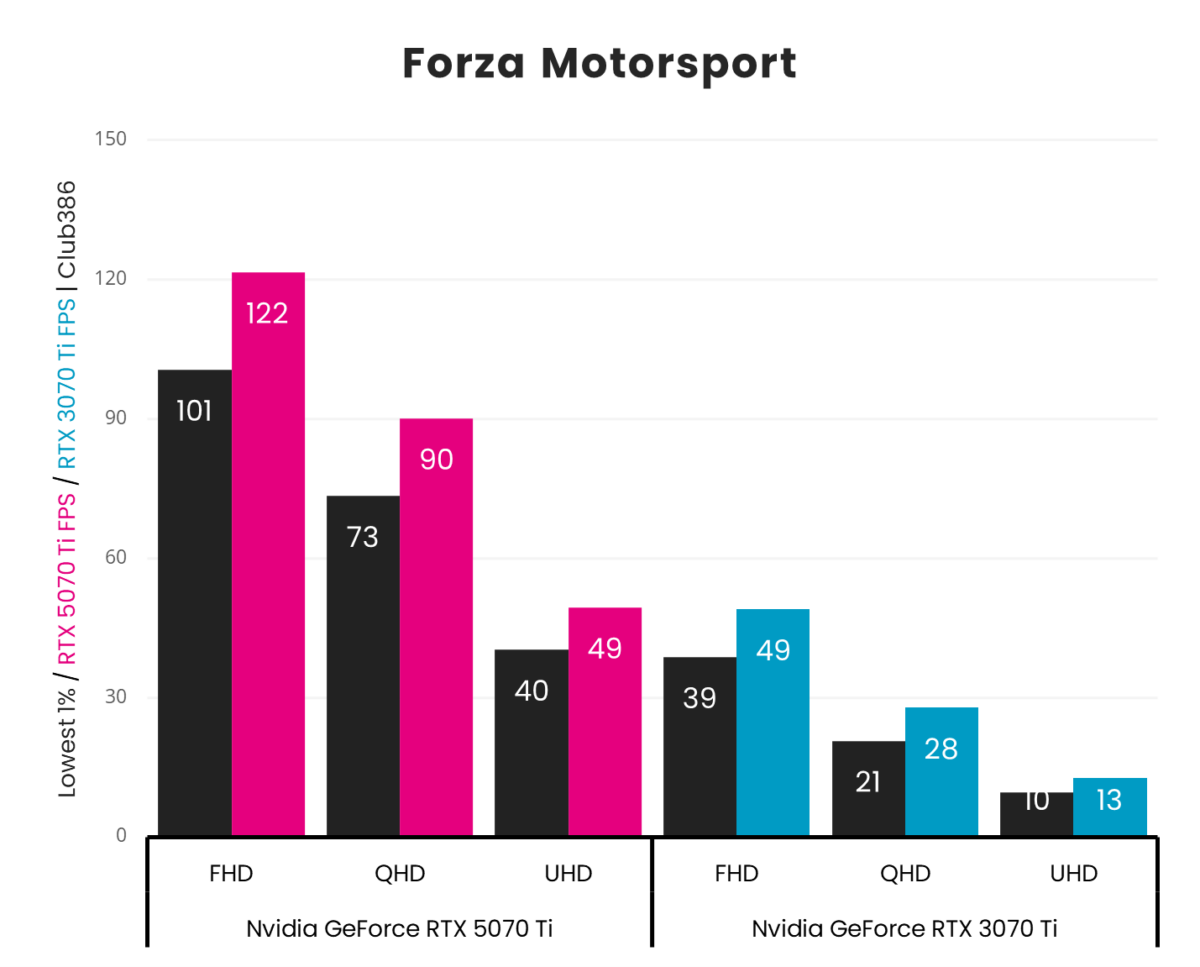
The future of rendering is ray tracing and it’s clear that GeForce RTX 3070 Ti is behind the times standing against RTX 5070 Ti in Forza Motorsport. Revving up its fourth generation tensor cores, the Blackwell graphics card drives frame rates to dizzying heights. At FHD, it more than doubles the performance of its forebear at FHD, more than triples it at QHD, and comes close to quadrupling it at UHD.
Sans upscaling at these settings, I’d argue GeForce RTX 3070 Ti doesn’t have the grunt necessary to run the game as I prefer average frame rates of 60fps at minimum in racing games. This also somewhat applies to RTX 5070 Ti at UHD, but I’ll happily take a lower resolution over less-than-ideal performance.
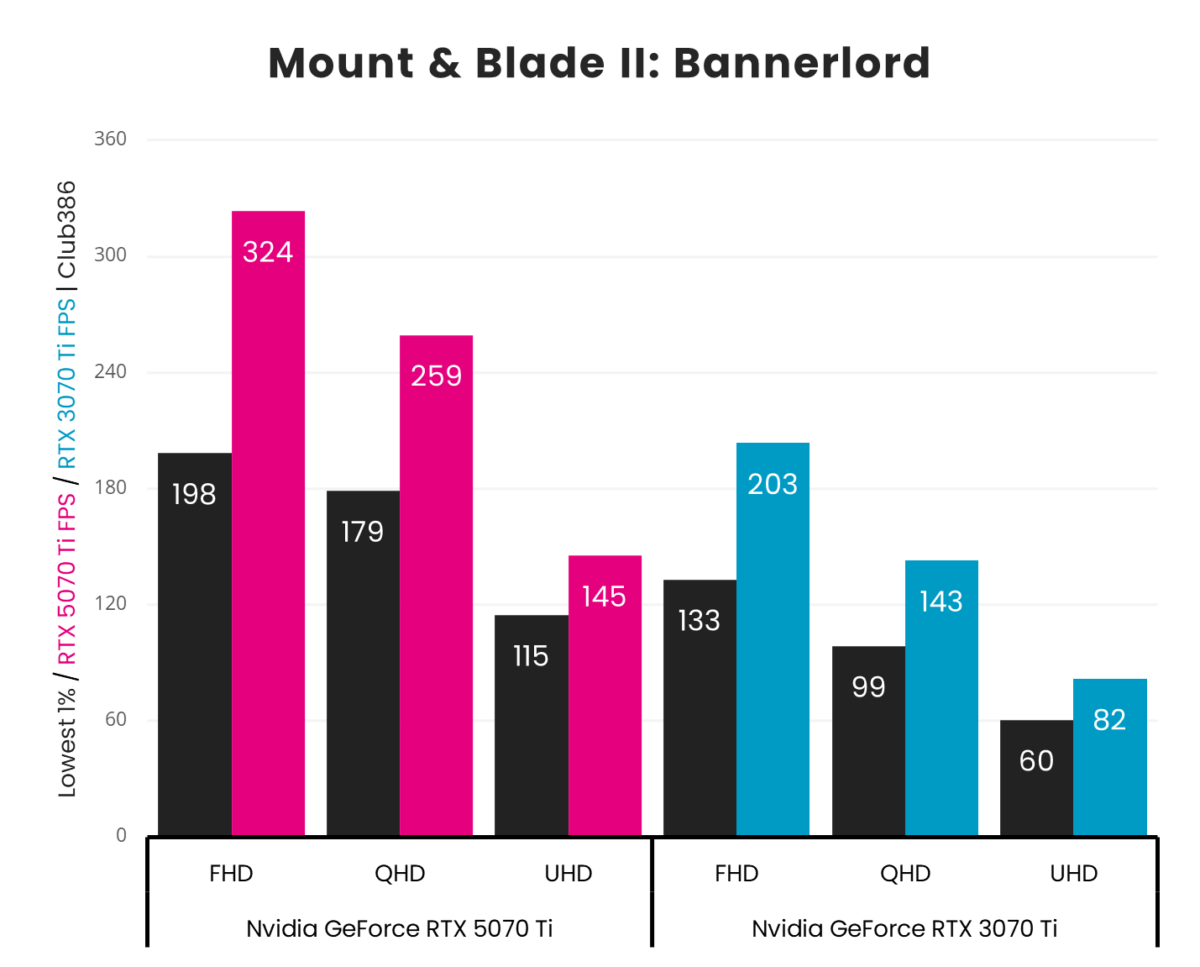
Returning to a rasterised battleground, Mount & Blade II is a fantastic showcase for the high refresh rate gaming potential of GeForce RTX 5070 Ti relative to RTX 3070 Ti. Across all three resolutions tested, it’s possible to play the RPG-strategy hybrid at 144fps thanks to performance uplifts of 60-81%.
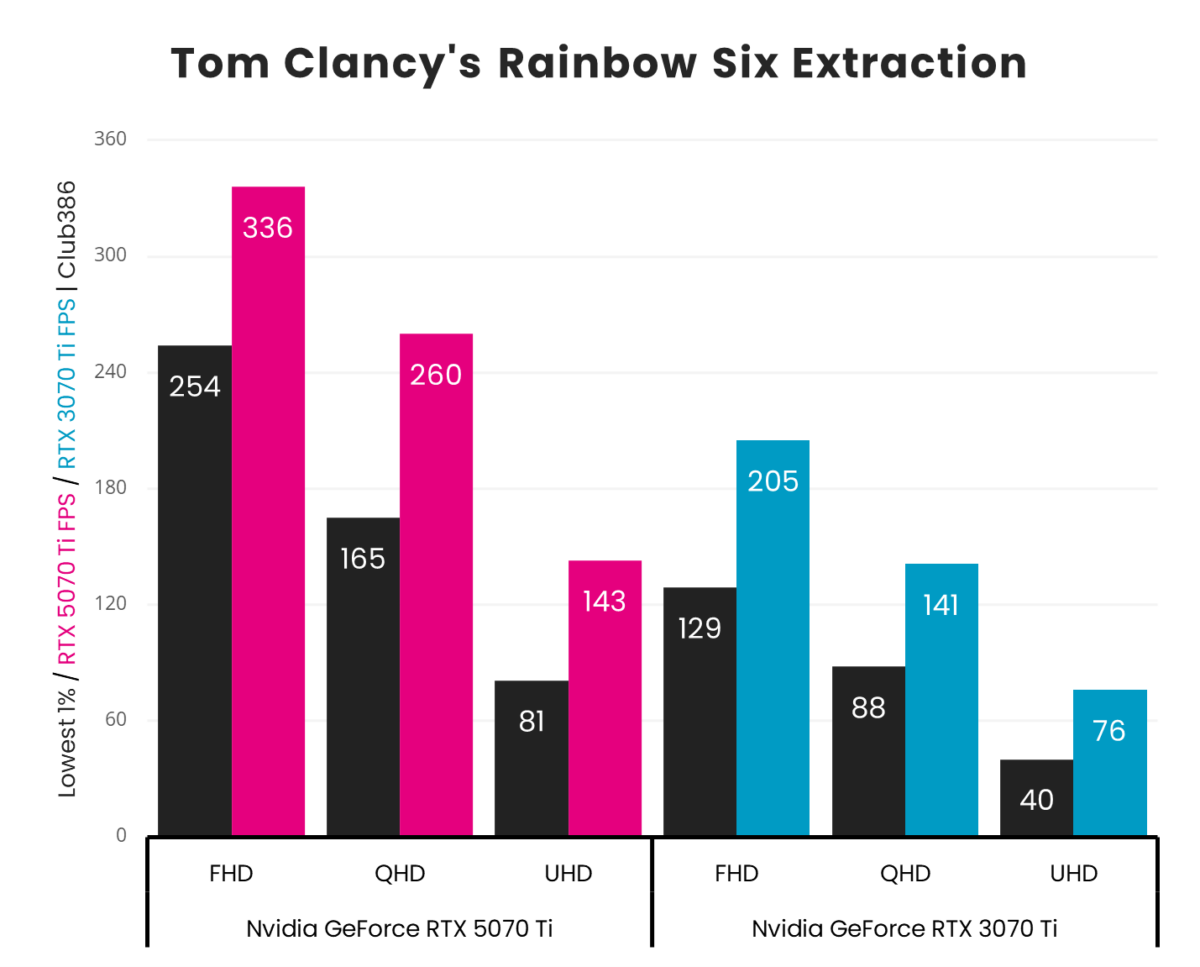
In competitive first-person shooters every frame matters. GeForce RTX 5070 Ti is a handful of frames short of a 360Hz experience at FHD, a common refresh rate and resolution combo for monitors aimed at esports enthusiasts. Meanwhile, RTX 3070 Ti is only just north of 200fps.
Generational improvements at QHD and UHD in Rainbow Six Extraction are impressive too, respectively clocking in at 84% and 88%. GeForce RTX 5070 Ti will also be among the first graphics cards to support Nvidia Reflex 2, building on Team Green’s latency reduction technology.
DLSS vs. FSR
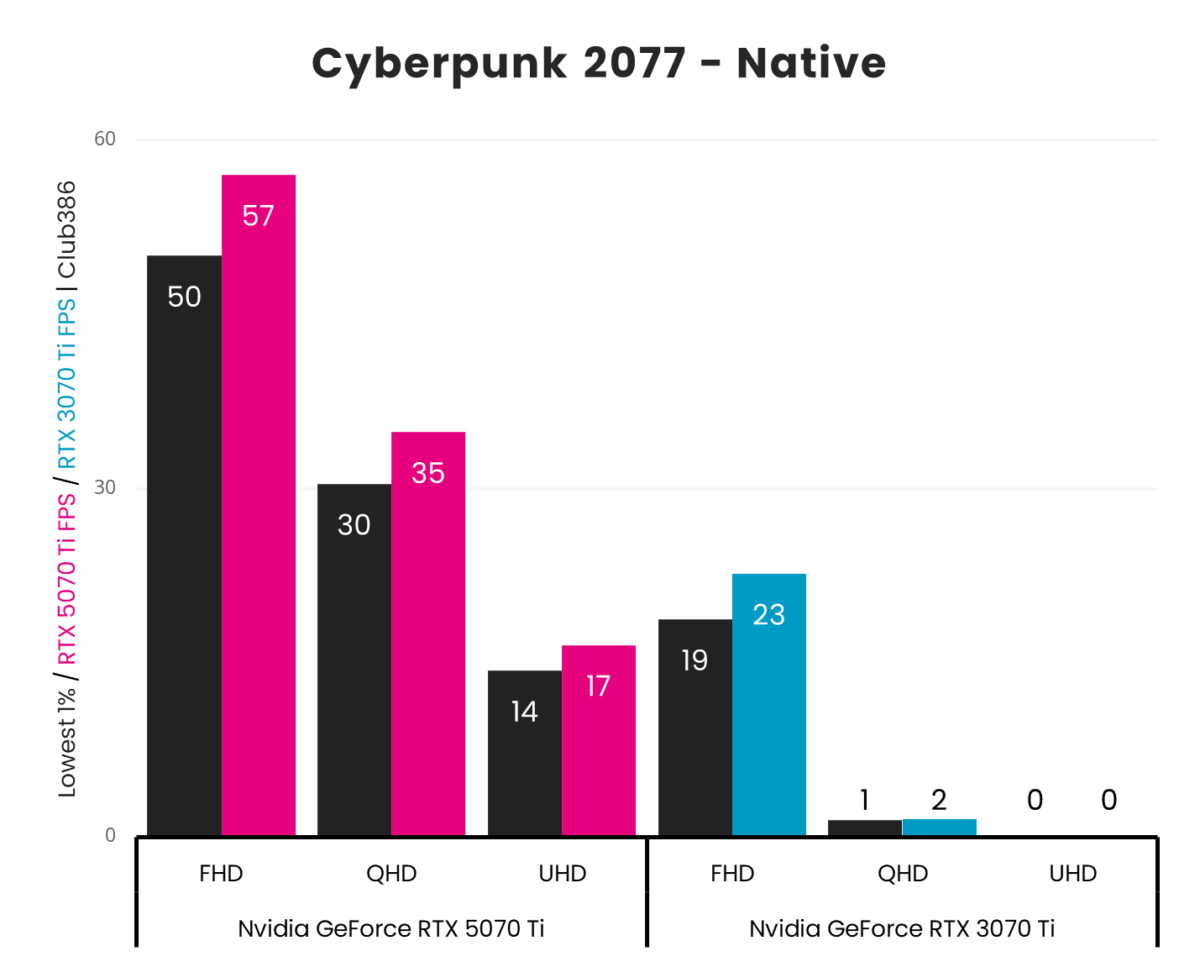
There was never much hope that GeForce RTX 3070 Ti would manage to run any kind of path tracing, just a fool’s hope. The Ampere card completely crashes out trying to render Cyberpunk 2077’s RT Overdrive settings at UHD. It also turns into a literal slideshow at QHD, but to its credit musters 23fps at FHD.
By contrast, GeForce RTX 5070 Ti summons the strength to finish the benchmark across all three resolutions. More impressive, still, it offers playable frame rates at both FHD and QHD. While the card doesn’t hit that ideal 60fps average, it’s still worlds better than its predecessor and it’s great to see such a demanding scenario perform so well on 70 Ti class hardware.
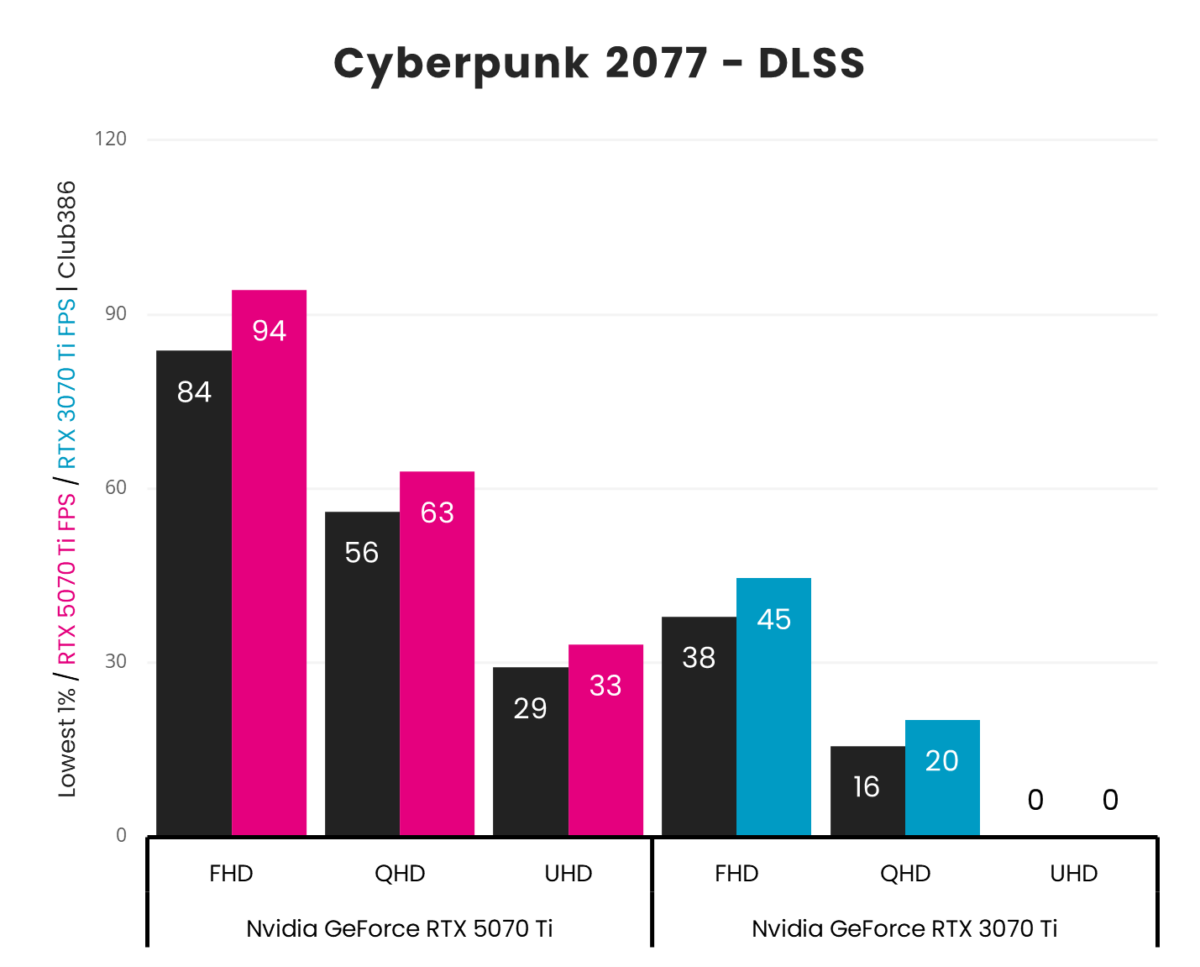
DLSS Super Resolution running in its ‘Quality’ preset helps GeForce RTX 3070 Ti come up for air at FHD and QHD, pushing north of 30fps at the former resolution while the latter sadly remains unplayable. The feature also does nothing to improve the card’s chances of completing the benchmark at 4K, let alone starting it.
GeForce RTX 5070 Ti meanwhile serves up double the frame rate of RTX 3070 Ti at FHD, and triples it at QHD, running both resolutions above 60fps. The pixel pusher also manages to provide a passable experience at UHD, pumping out 33fps, which could increase further through a less-taxing DLSS preset.
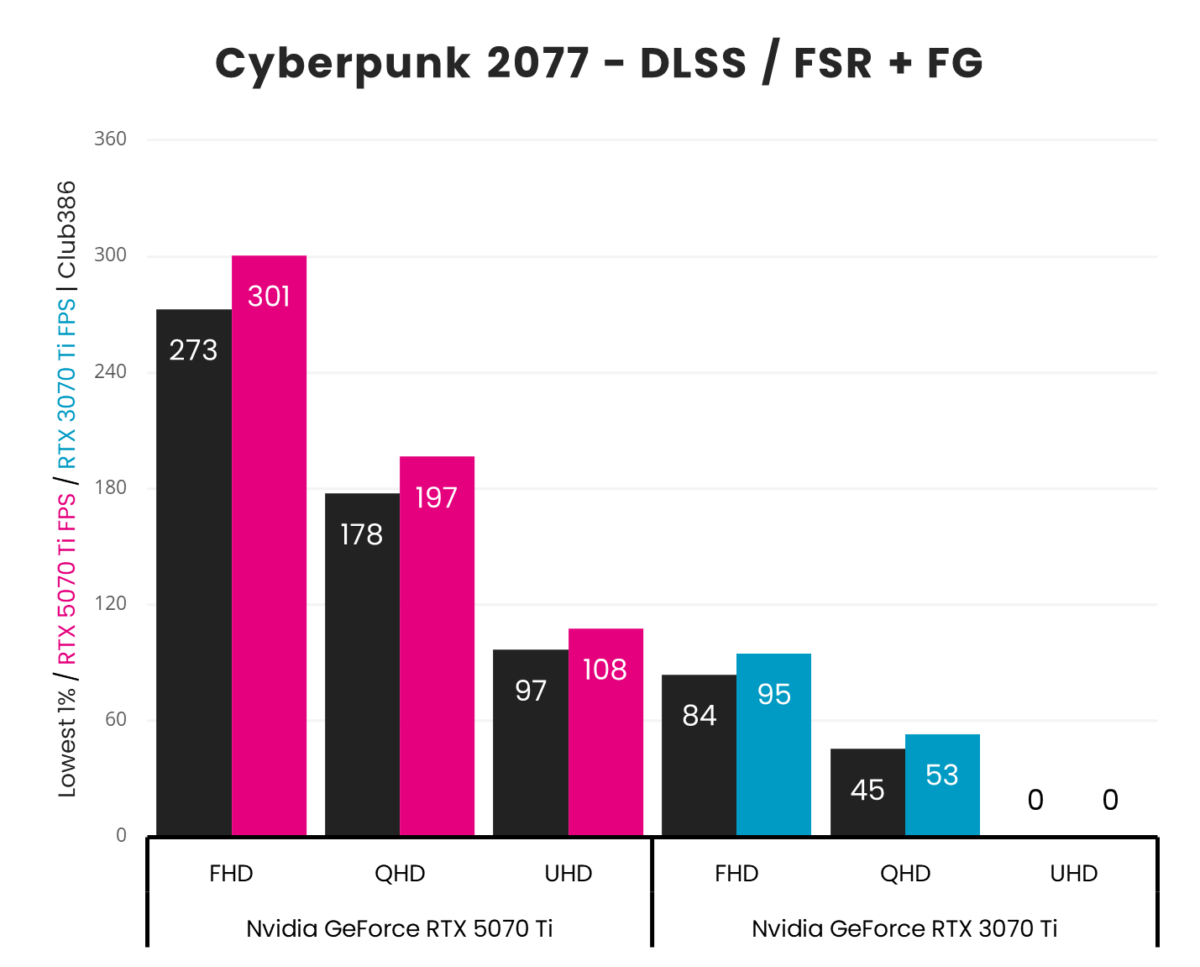
Lacking support for DLSS Frame Generation, GeForce RTX 3070 Ti must rely on FSR for any sort of frame generation but this comes part and parcel with its upscaling too. While this does lead to an increase in performance it comes at the cost of fidelity relative to DLSS Super Resolution. This is especially problematic for the Ampere card as it needs to push below the ‘Ultra Quality’ preset in order to reach a base frame rate 60fps, the minimum level of performance necessary for an ideal frame generation experience.
Naturally, none of these problems affect GeForce RT 5070 Ti. It flourishes with DLSS Multi Frame Generation in tow, firing out triple-digit frame rates across all three resolutions. More frames at higher quality, there’s no denying its superior feature set.
Vitals
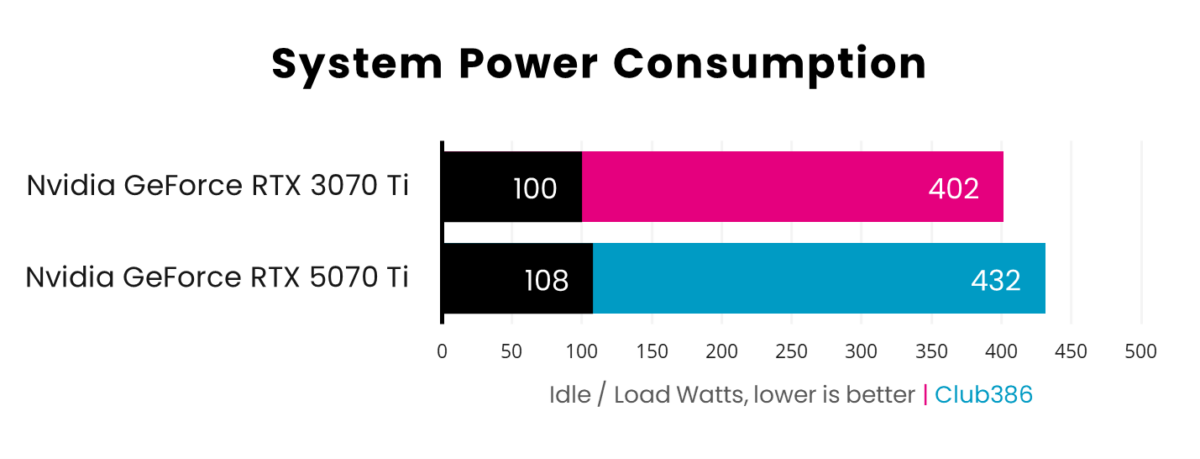
As expected, GeForce RTX 5070 Ti pulls slightly more power from the wall than RTX 3070 Ti. An additional 8-30W is nothing to lose sleep over, particularly when the new card puts them to much better use.
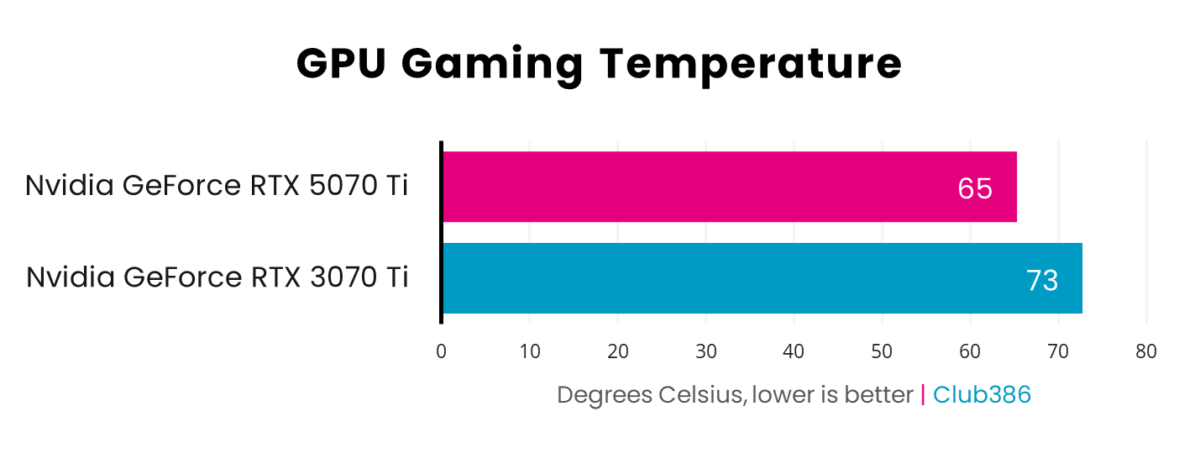
MSI’s Ventus 3X does a great job at keeping GeForce RTX 5070 Ti cool, clearing Nvidia’s RTX 3070 Ti Founders Edition by 8°C. Thermal management will naturally vary across board partner designs but there’s little room if any for error in selecting a quality cooler.
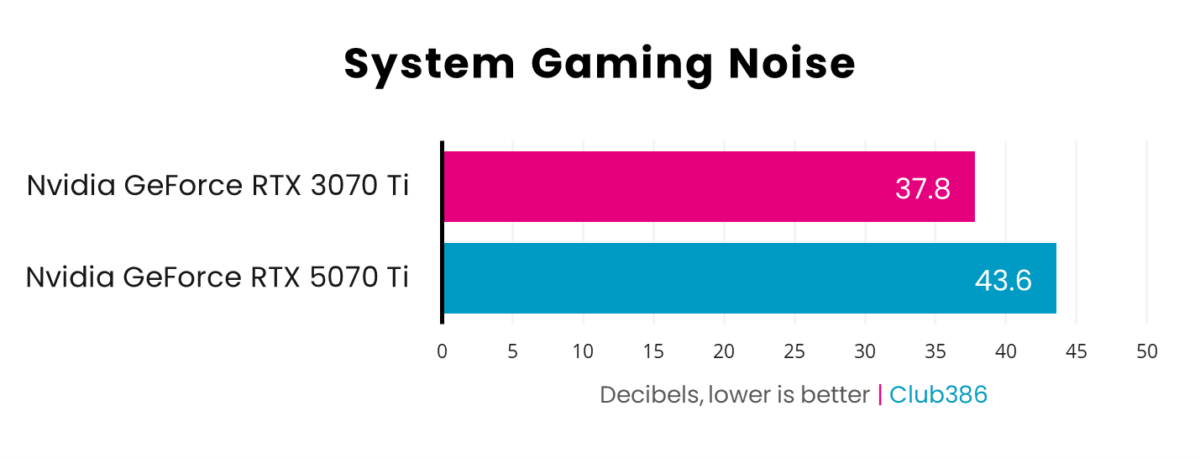
Noise profiles of GeForce RTX 5070 Ti will vary like thermal management owing to the design decisions of board partners. Ventus 3X in this case is audibly louder than RTX 3070 Ti Founders Edition but it’s nothing overbearing or that a good headset can’t block out.
Conclusion
If you’re rocking GeForce RTX 3070 Ti and hankering for an upgrade then RTX 5070 Ti is well worth opting for. Its feature set and specifications are far more robust, working together to form a graphics card that blows its predecessor out of the water. Just know that it unfortunately may be difficult to find a model at MSRP, let alone any stock for the SKU.
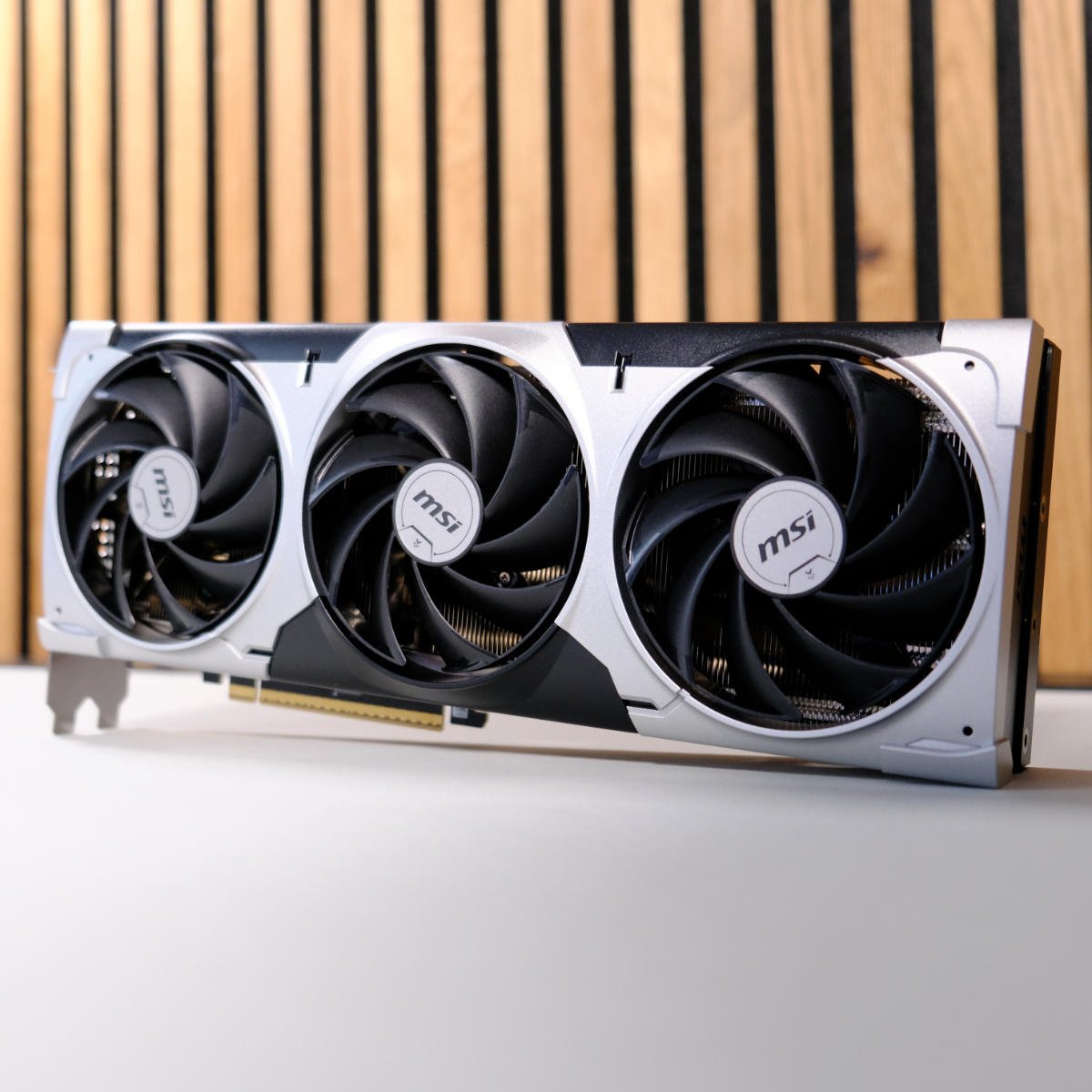
GeForce RTX 5070 Ti
“Transforming Nvidia’s Blackwell GPU range into a trio, MSI GeForce RTX 5070 Ti Ventus 3X promises big things wrapped in its $749 MSRP.” Read our review.
Another potential upgrade path is on the horizon in the form of Radeon RX 9070 XT and RX 9070 but those cards are yet to prove themselves. Waiting a while longer to replace your GeForce RTX 3070 Ti is the smart move, whether to allow stock levels and pricing to normalise or see how the competition stacks up.
In the meantime, check out how GeForce RTX 5070 Ti stacks up against RTX 4070 Ti Super and Radeon RX 7900 XT.


